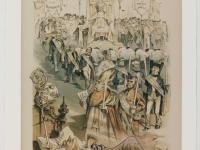Sometimes taking the extra minute to dive into the history of a document can help uncover an array of information previously unconsidered. The Pope’s Dream, is often used with students in our archives to illustrate the anti-Irish sentiment in the United States at the end of the 19th century. It is an excellently detailed image and students are very quick to grasp the idea that the author believes the Pope wishes to take over the United States and place Church before State.Yet, if we look at this image more closely, we can see that the man leading the way is holding a tablet that says “Ministry of Public Education.” This is because people feared that the Pope featured in this cartoon, Pope Leo XIII, was trying to “take over” our public school systems. It also does not help that he authorized the founding of “The Catholic University of America.”
So who was Pope Leo XIII? Surprisingly, he was more of a modernist than you would expect. Pope Leo XIII was a reformer compared to his predecessor, denouncing anti-Semitism, preaching against racism, and believing that the church and science could co-exist. Pretty radical stuff for a Pope in the late 1800’s. In fact, many conservative individuals did not like him because he was not conservative enough, and his focus on helping the working class and the laboring poor in many countries often put him at odds with his own constituents.
While Pope Leo XIII will most likely not be on an AP History exam, this is a perfect example to never judge a book by its cover, or, in this case, a cartoon, and the importance of showing students the historical context surrounding an event. Pope Leo XIII never wanted to be King of the United States, nor did he ever try to be. Rather, the pontiff was associated with poor Irish-Catholic immigrants which was unfavorable at the time. In your classroon, set up this discussion by explaining to students that, at the time, many Americans were distrustful of recent immigrants and felt that their allegiance was to their home country, or the Catholic Church, rather than the United States.
For further inquiry, supplement this cartoon with a very brief article from an interview Pope Leo XIII had with a French journalist, Severine, where he denounces anti-Semitism and racial discrimination. Although this article is more about France its brevity gets the point across that Pope Leo XIII did not believe in discrimination of any kind. After reading the brief article, ask students: What did Pope Leo XIII stand for? What was he trying to accomplish as Pope? What group is he actually trying to help? Would you consider him modern, conservative, progressive? Why or why not?
For more background information on many of our cartoons please check out Poltics in Graphic Detail and our Political Cartoon Unit Plans.

